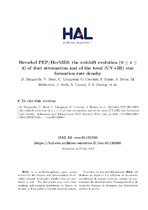Herschel PEP/HerMES: the redshift evolution of dust attenuation and of the total (UV+IR) star formation rate density
Date
2013Author
Burgarella, D.
Buat, V.
Gruppioni, C.
Cucciati, O.
Heinis, S.
Berta, S.
Bethermin, M.
Bock, J.
Cooray, Asantha
Dunlop, J.S.
Farrah, D.
Franceschini, Alberto
Le Floch, E.
Lutz, D.
Magnelli, B.
Nordon, R.
Oliver, S.J.
Page, Matthew J.
Popesso, P.
Pozzi, F.
Riguccini, L.
Vaccari, M.
Viero, M. P.
Metadata
Show full item recordAbstract
Using new homogeneous luminosity functions (LFs) in the far-ultraviolet (FUV) from VVDS and in the far-infrared (FIR) from Herschel/PEP and Herschel/HerMES, we studied the evolution of the dust attenuation with redshift. With this information, we were able to estimate the redshift evolution of the total (FUV + FIR) star formation rate density (SFRDTOT). By integrating SFRDTOT, we followed the mass building and analyzed the redshift evolution of the stellar mass density (SMD). This article aims at providing a complete view of star formation from the local Universe to z ~ 4 and, using assumptions on earlier star formation history, compares this evolution with previously published data in an attempt to draw a homogeneous picture of the global evolution of star formation in galaxies. Our main conclusions are that: 1) the dust attenuation AFUV is found to increase from z = 0 to z ~ 1.2 and then starts to decrease until our last data point at z = 3.6; 2) the estimated SFRD confirms published results to z ~ 2. At z > 2, we observe either a plateau or a small increase up to z ~ 3 and then a likely decrease up to z = 3.6; 3) the peak of AFUV is delayed with respect to the plateau of SFRDTOT and a probable origin might be found in the evolution of the bright ends of the FUV and FIR LFs; 4) using assumptions (exponential rise and linear rise with time) for the evolution of the star formation density from z = 3.6 to zform = 10, we integrated SFRDTOT and obtained a good agreement with the published SMDs.

